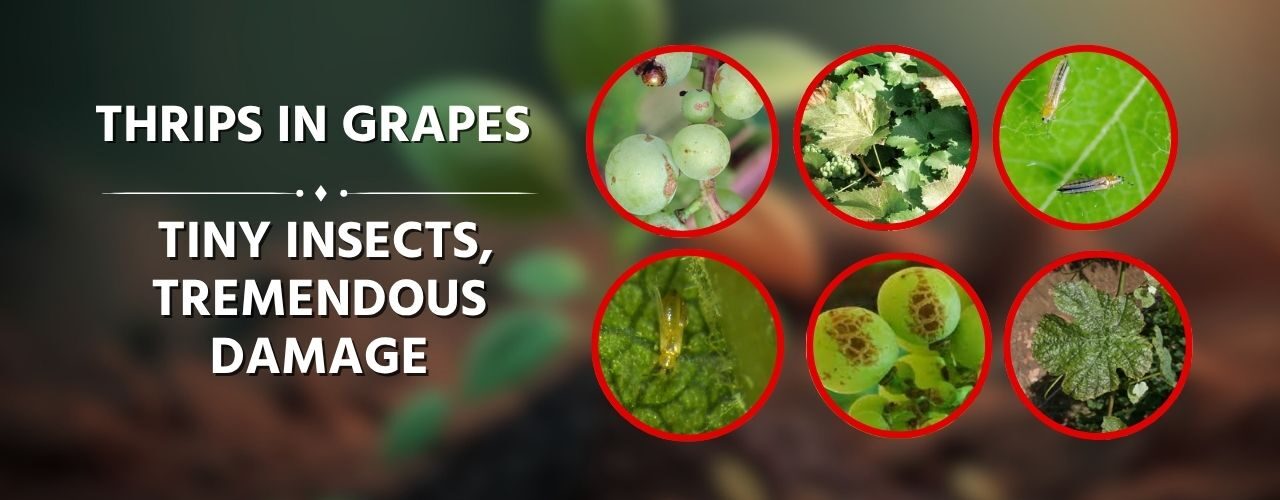Thrips in Grapes – Tiny Insects, Tremendous Damage
Thrips are minute, cigar-shaped, slender-bodied insects belonging to the order Thysanoptera, whose name refers to the fringed wings of insects in this order. Thrips damage grapevines by puncturing plant cells and sucking out their contents. Their rasping and sucking mouthparts leave behind silvered patches and brown scars, particularly on young leaves, flowers, and berries. Infestations are hard to detect until damage is visible, and their population can explode rapidly under dry conditions. They are typically only 1-2 mm in length, making them difficult to spot with the naked eye. Their color can vary from yellow to brown or black, depending on the species.
In grapevines, common pest species include the Grape Thrips (Drepanothrips reuteri) and the Western Flower Thrips (Frankliniella occidentalis), though other species can also cause damage such as – Scirtothrips dorsalis, Thrips palmi, Thrips hawaiiensis, Rhipiphorothrips cruentatus, etc
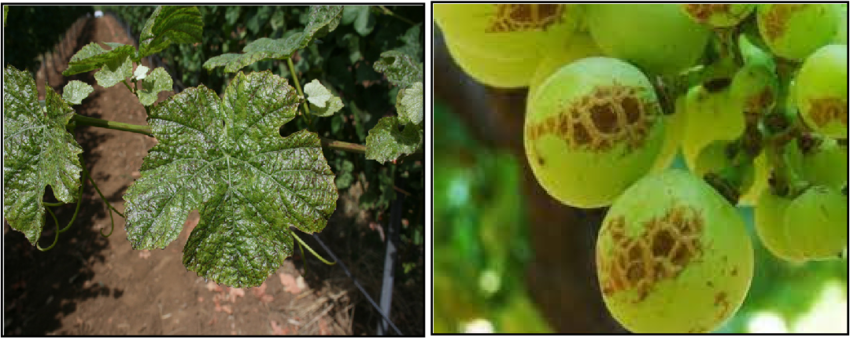

Table of Contents
Thrips Biology: All Stages of Life
Thrips undergo a unique life cycle with several distinct stages, including both active feeding and quiescent (non-feeding) stages. Though it has a pupal stage, nymphs resemble almost like adults, their life cycle is categorized under incomplete metamorphosis.
1. Egg Stage:
- Appearance: Tiny, translucent, kidney-bean shaped, or banana-shaped.
- Location: Females insert their eggs individually into the plant tissue, typically within young leaves, flower parts, or tender fruit.
- Duration: The egg stage generally lasts for 2 to 6 days, depending on temperature.
2. Larval Stages (Nymphs):
- Appearance: Larvae (often called nymphs) resemble miniature, wingless versions of adults. They are typically pale yellow to transparent, often with red eyes.
- Activity: These are active feeding stages. There are usually two instars.
- Location: They feed on the tender plant parts where they hatched, such as young leaves, shoots, and developing flowers or berries.
- Duration: The two nymphal stages together can last for 5 to 10 days.
3. Prepupal Stage:
- Appearance: This is a non-feeding, quiescent stage. Nymphs stop feeding and develop wing pads, with antennae folded back over their heads. They are typically pale yellow.
- Location: Prepupae often drop to the soil or move into protected areas on the plant (e.g., leaf litter, crevices in bark) to pupate.
- Duration: This stage typically lasts for 1 to 2 days.
4. Pupal Stage:
- Appearance: Similar to the prepupal stage but with more developed wing pads and antennae folded further back. This is also a non-feeding, quiescent stage.
- Location: Primarily in the soil or protected crevices on the plant.
- Duration: This stage typically lasts for 1 to 3 days.
5. Adult Stage (Male and Female):
- Appearance: Adults are winged (though some species can be wingless), slender, and small. They have characteristic fringed wings. Males are generally smaller than females.
- Activity: Both adult males and females feed on plant sap. Females can reproduce sexually or asexually (parthenogenesis – laying eggs without mating).
- Duration: Adult thrips can live for 3 to 5 weeks, with females laying numerous eggs (e.g., about 55 eggs per female).
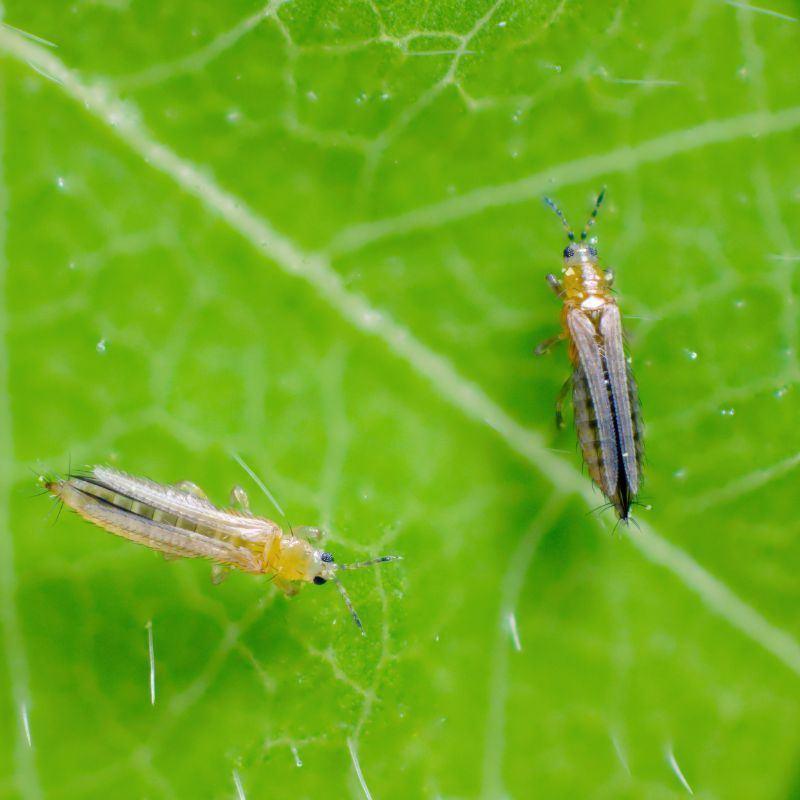
Adult and nymph of thrips.
Lifecycle of Thrips in Detail with Number of Days
The entire life cycle of thrips from egg to adult can be completed very rapidly, often in as little as 18 to 30 days under optimal warm conditions. This short generation time allows for rapid population build-up.
- Egg: 2-6 days
- Larva (Nymph) Instar I: 2-5 days
- Larva (Nymph) Instar II: 3-5 days
- Prepupa: 1-2 days
- Pupa: 1-3 days
- Adult: 3-5 weeks
This rapid succession of generations means multiple overlapping generations can occur within a single grape growing season, leading to continuous pest pressure.
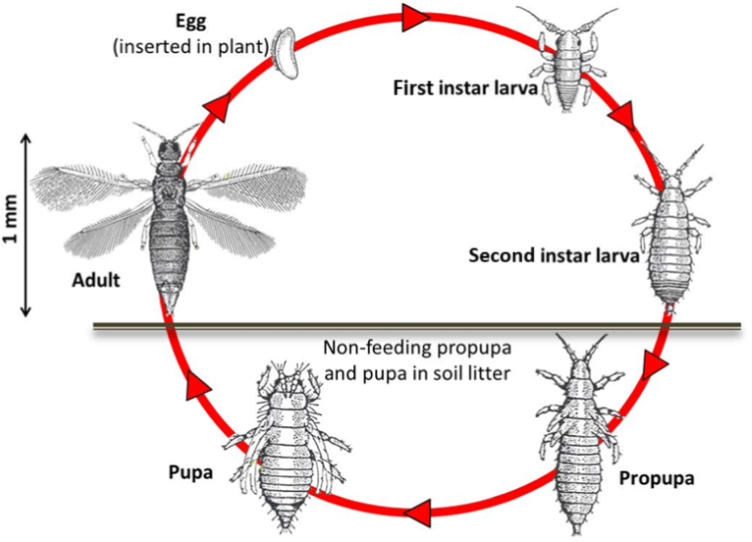
Source: researchgate.net
Mode of Spread of Thrips
Thrips can spread in several ways:
- Wind Dispersal: Their small size and fringed wings make them easily airborne, allowing them to drift long distances on wind currents. This is a primary mode of spread between vineyards and even regions.
- Infested Plant Material: Movement of infested nursery stock, cuttings, or other plant material can introduce thrips into new areas.
- Human Activity: Thrips can hitchhike on clothing, equipment, or vehicles, inadvertently being transported from one field to another.
- Movement from Weeds/Alternative Hosts: Thrips often breed on weeds or other alternative host plants within or around the vineyard. As these hosts dry out or become less suitable, thrips migrate to the grapevines.
Nature of Damage
Damage from Feeding:
Thrips have unique rasping and sucking mouthparts that are asymmetrical due to the reduction or absence of the right mandible. This allows them to rasp plant surfaces, creating a wound, and then suck up the released fluids. This feeding mechanism is described as rasping-sucking or sometimes piercing-sucking. This mechanism leads to characteristic damage:
- Silvering or Bronzing: As cells are emptied of chlorophyll and air fills the void, affected tissues take on a silvery, grayish, or bronzed appearance. This is often accompanied by tiny black specks of their excrement (frass).
- Stippling and Flecking: Minute spots or discolored flecks appear on the plant surface.
- Distortion and Stunting: Feeding on young, developing tissues can lead to distorted or stunted growth, especially on shoots and leaves.
Damage to Grapes: Specific Symptoms
Damage to Grapes Flowers (Inflorescence):
- Thrips feed on developing flower parts, leading to discolored, distorted, or aborted flowers.
- Heavy feeding can reduce pollination and fruit set, directly impacting yield potential.
- In severe infestations, entire flower clusters can dry up and drop.
Damage to Grapes Fruits (Berries):
- Scarring and Russeting: Thrips feeding on young berries causes superficial scars, often appearing as a fine, pin-prick pattern or corky brown patches. This is particularly problematic for table grapes, where appearance is critical.
- Halo Spotting: Western Flower Thrips can lay eggs in berries during bloom or fruit set, leading to small, circular “halo spots” on the ripening fruit.
- Deformation: Early feeding can lead to misshapen or underdeveloped berries.
- Reduced Marketability: The cosmetic damage, especially scarring and discoloration, significantly reduces the market value of table grapes. In wine grapes, severe damage can impact quality but is less of a concern than for fresh consumption.
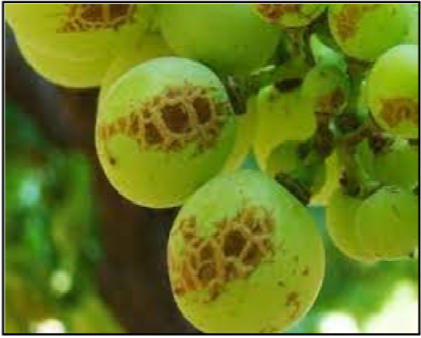
Corky Brown Patches caused by Thrips feeding
Image source – researchgate.net
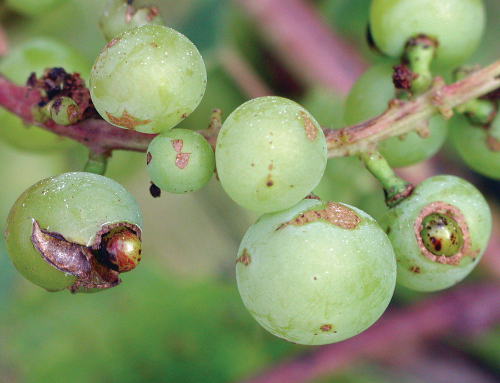
Scars caused by thrips due to thrips feeding
Image source – canr.msu.edu
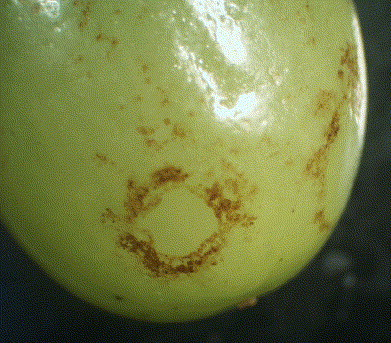
Scaring caused by thrips feeding
Image source –sciencedirect.com
Damage to Leaves and Twigs/Vines:
- Silvery Streaks/Patches: On leaves, thrips feeding causes characteristic silvery streaks or patches, often more noticeable on the underside.
- Leaf Distortion: Feeding on young, expanding leaves can cause them to curl, crinkle, or become distorted.
- Black Specks: Tiny black dots of thrips excrement are often visible on the damaged areas.
- Stunting: In severe cases, particularly on young vines or new growth, heavy thrips feeding can stunt shoot development.

Silvering caused by thrips also produces drops of brown excrement to repel predators.
Image source – www.safj.co.za/

Symptoms on leaves – Bronzing
Image source – researchgate.net
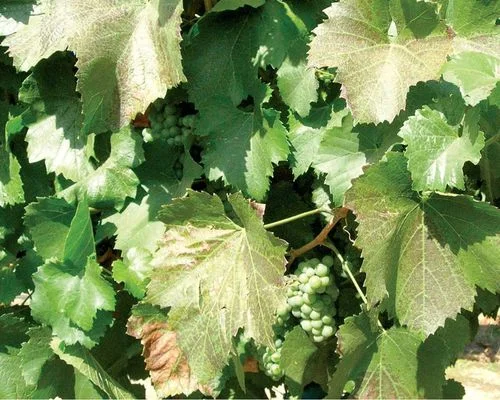
Symptoms on leaves – Bronzing
Image Source – katyayanikrishidirect.com
Key Factors Influencing Thrips Infestation
Positive and Negative Correlation with Weather Factors:
- Temperature: Thrips populations generally thrive in warm to hot temperatures (typically 20°C to 32°C / 68°F to 90°F). Warmer temperatures accelerate their life cycle, leading to more rapid reproduction and population growth. There is often a positive correlation between increasing temperature (within their optimal range) and thrips population density.
- Humidity: Thrips generally prefer dry conditions and low humidity. High humidity can be detrimental to their soft bodies and can also promote fungal pathogens that attack thrips. Therefore, there is often a negative correlation between high humidity and thrips populations. Dry periods, especially those following initial rainfall, can favor their multiplication.
- Rainfall: Heavy or prolonged rainfall can have a negative impact on thrips populations by washing them off plants and disrupting their activity. However, light or intermittent rain, especially if followed by dry periods, might not significantly deter them and can even facilitate movement.
- Wind: Wind is a crucial factor in thrips dispersal, acting as a positive correlation for their spread to new areas. However, strong winds can also dislodge them from plants.
Seasonal Patterns of Thrips Infestation
In many grape-growing regions of India, thrips infestation typically follows seasonal patterns:
- Early Season (Bud Break to Pre-Bloom): Thrips may be active on emerging shoots and young leaves. Populations can be low but can cause early damage if conditions are favorable.
- Flowering and Fruit Set: This is a critical period for thrips damage to flowers and newly set berries. Populations often peak during bloom and early fruit development, especially the Western Flower Thrips.
- Mid-Season (Berry Development): Damage to berries continues, particularly superficial scarring. Thrips may also feed on new vegetative growth.
- Late Season/Harvest: As berries ripen, thrips can cause damage to the fruit surface, especially where berries touch within a cluster.
Integrated Management Practices for Thrips Control (IPM)
An integrated approach is essential for effective and sustainable thrips management in grapes.
Monitoring:
- Yellow or Blue Sticky Traps: Thrips are attracted to these colors. Place sticky traps just above the canopy level to monitor adult populations and detect their presence early.
Visual Inspection: Regularly inspect young shoots, unfolding leaves, flower clusters, and developing berries for the presence of thrips (adults and nymphs) and characteristic damage symptoms (silvering, black specks). Shake clusters over a white sheet of paper to dislodge and count thrips.
Cultural Control:
- Weed Management: Keep vineyard rows and surrounding areas free of weeds that can serve as alternative hosts and breeding grounds for thrips.
- Canopy Management: Pruning, shoot thinning, and leaf removal to create an open canopy improve air circulation and light penetration, making the environment less favorable for thrips and improving spray coverage.
- Irrigation: Use drip irrigation to avoid wetting foliage and fruit, as thrips prefer dry conditions.
Judicious use of fertilizers
One of the major reasons behind frequent pest attacks is the excessive or injudicious use of nitrogen-based fertilizers. When too much nitrogen is applied, the plant tissues become overly soft and succulent, making them easier for insects to chew and digest. This weakens the plant’s natural resistance to pests. Similarly, overuse of phosphatic fertilizers can lock up essential nutrients like calcium, magnesium, and iron in the soil. Since phosphorus is immobile, it stays fixed in one place and does not reach all parts of the root zone. This nutrient imbalance hampers complete protein development in the plant and disrupts enzymatic functions that are crucial for pest defense.
Huntin Organics suggests a combination of foliar sprays and soil application for comprehensive thrips control, aiming for a “permanent farming solution” by disrupting the thrips lifecycle
Huntin’s Recommendation for Thrips Management in Grapes
For Prevention (Proactive Approach):
To keep thrips population under control and prevent damage:
All Rounder – 2 ml/L
• NanoSulf – 2 ml/L
• NanoReach – 1 ml/L
✅ Spray this combination every 15 to 20 days throughout the season to maintain a protective shield and deter thrips activity in the vineyard.
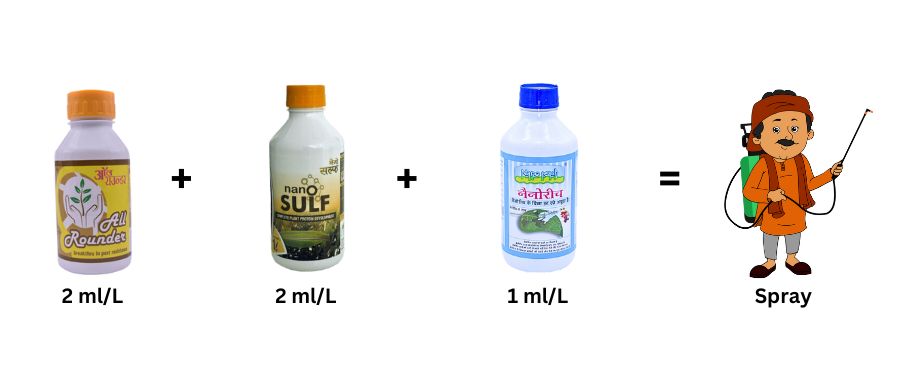
For Control (Curative Approach):
In case of active thrips infestation:
All Rounder – 2.5 ml/L
• NanoSulf – 2 ml/L
• Recommended insecticide for thrips (to suppress the heavy population)
• NanoReach – 1 ml/L
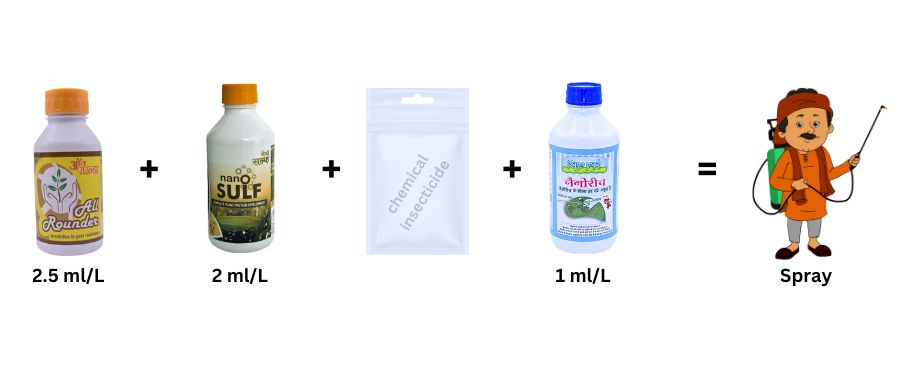
✅ Continue with 3 consecutive sprays at 7-day intervals (stop using chemical insecticide once population is reduced).
✅ Once infestation is brought under control, spray All Rounder 2 ml/L, NanoSulf 2 ml/L & NanoReach 1 ml/L at an interval of every 10–15 days.
🔹 Soil Application to Break Lifecycle:
• Nok-Out – 250 ml/acre

✅ Apply through irrigation to target the resting pupal stage of thrips in the soil.
✅ Repeat monthly to effectively break one critical stage in the thrips lifecycle and reduce recurrence.
A Brief Product Details :
Nok-out is a consortia of 4 heat and salt-tolerant strains of beneficial fungus (Verticillium spp., Peacilomyces spp., Beauveria spp., Metarhizium spp., in spore form technology with nano gel polymers
https://huntinorganics.com/product/nokout/
Nanosulf is nano tech. based neem product containing sulphur and potash in nano forms
https://huntinorganics.com/product/nano-sulf/
Nanoreach is a non-ionic based 100% pure silicone surfactant, spreader, and adjuvant to improve efficiency of every pesticide/weedicide/nutrients by high stomatal infiltration
https://huntinorganics.com/product/nano-reach/
All Rounder is neem based product having essential oil and several components of azadirachtin; the product has great emulsion and a unique smell that makes it outstanding with unwavering stability during field application
https://huntinorganics.com/product/all-rounder/
Note: These products are safe for beneficial insect populations, including predatory beetles, ladybird beetles, lacewing larvae, and parasitoid wasps
For more details on grapes’ diseases & insect pest and their control, please visit- https://huntinorganics.com/crops/grapes/

